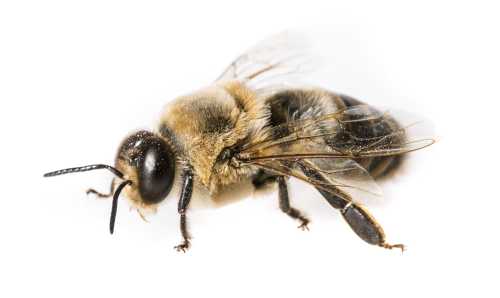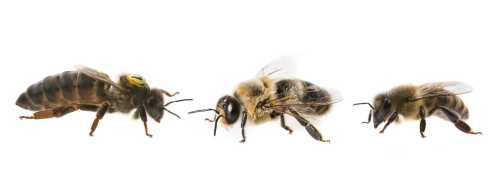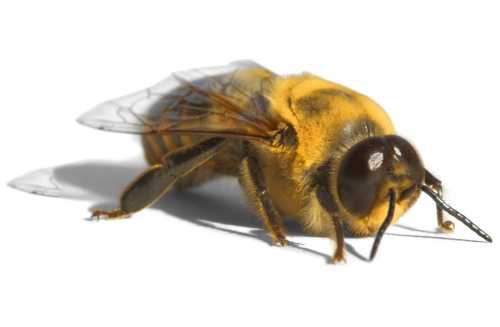Drone Bee:
The life of the Male Honey Bee - (Apis mellifera)
Updated: November 2023
Drones are fertile male honey bees, and they are vital for the survival of honey bee colonies.
Their primary role is to mate with a receptive queen honey bee, in
order to ensure future generations of honey bees, and indeed, expansion
and creation of new colonies.
I've heard it said that drones don't do much because (say some):
- Drones do little around the hive or nest - they don't clean or build honey combs, for example.
- They help themselves to nectar stores.
- They don’t collect food for the colony.
- It is sometimes said that drones spend their time drinking nectar, mating,
and lazing around on flowers.
In fact, one scientific paper by Kova et al remarks:
"Honeybee drones are often called “lazy Willi” (Bonsels, 1912) and are often assumed to merely function as “flying sperm”, necessary to inseminate virgin queens".
The scientist goes on to say,
"This view, however, is not correct." (1).
The fact is:
Drones perform precisely the role that nature gave them, and as such, they are a vital part of the honey bee colony.
In addition, understanding of the broader role of drones within the bee colony is increasing with further scientific research.
Below, you can read about the importance of honey bee drones.
 A drone honey bee
A drone honey beeAbout The Drone Bee
10 Fast Facts About Honey Bee Drones
|
How Large And Strong Are Drone Bees?
Drones can vary widely in size, but they are larger than workers, and smaller than queen honey bees although they are stockier in build. The cells they develop from are slightly larger than worker cells.
These are a not only the colony’s brawniest bees. They have huge eyes in comparison with queen and worker honey bees, which assist drones in spying young queens out on nuptial fights.
Drones also have massive flight muscles for chasing after the queens at speeds up to 35 kilometers an hour (about 22 miles per hour).
 Relative sizes of honey bee colony members, from left to right: queen, drone, worker. Note the large eyes of the drone.
Relative sizes of honey bee colony members, from left to right: queen, drone, worker. Note the large eyes of the drone.
4 Key Roles Of Drones In the Honey Bee (Apis Mellifera) colony
- Drones ensure the continuation of honey bees as a species, by mating with queens.
- Drones can pass on important behavioural traits to new generations of honey bees, (such as hygenic behaviours) through their genes(2).
- Drones help to regulate the temperature in the hive or nest, and this is especially important for the development of young bees and larvae. Honey bee larvae and pupae are extremely stenothermic, which means they strongly depend on accurate regulation of brood nest temperature for proper development (33–36°C)(1).
- Although each colony has far fewer drones than workers, they nevertheless pull their weight with regard to heat generation.
Research indicates that drones can produce one and a half times as much heat as a worker bee, and that even those drones not directly next to the brood, are nevertheless assisting with heat regulation inside the nest(3).
Fatherless Drones
|
WACKY FACT ABOUT DRONES: A honey bee drone has no father, but he does have a grandfather! |
Drones are 'haploid', having been reared from an unfertilized egg. As a result, a drone has only half the chromosomes of a worker bee or queen bee - the drone has 16 chromosomes, workers and queens have 32.
(That honey bee drones are haploid was first discovered in 1845 by a Polish apiarist, named Jan Dzierżon - often described as the "father of modern apiculture" - see History Of Beekeeping).
Being haploid means that drones can have a grandfather and grandsons, but a drone cannot have sons!
To explain further:
Drones come from unfertilized eggs (they are 'haploid'), meaning that no male (drone) was needed in order for the queen to produce more males - in other words, they are formed without a male 'parent'.
(In fact, at various times, female worker bees can, and do also lay eggs that create drones, despite the fact that they do not mate with males - they are referred to as 'drone laying workers'. This activity is usually suppressed by the queen or policed by other colony members).
But what about the queen - the mother of all the drones?
In order for a queen to produce new queens, eggs must be fertilized, for which drone bees are necessary. This means that the queen (the "mother" of the drone), has a "father" - obviously a drone. This also means that any drones produced by the queen, actually do have a "grandfather" (i.e. the "father" of the queen) - more specifically, a "maternal grandfather" (the father of the queen).
Put yet another way and more succinctly:
The queen who laid the drone eggs, is the offspring of
an egg fertilized by a drone (male). Drones themselves, however, are
the offspring of eggs that have not been fertilized by a male, and they are therefore, fatherless.
This scenario, whereby offspring are reared from unfertilized eggs, is referred to by biologists as ‘parthenogenesis’.
Drone Mating Behaviour
Each honey bee colony is a superorganism that will produce several hundred drones (in contrast with the thousands of workers).
On warm and sunny afternoons during the mating season, sexually mature
drones, fly out of the nest (or hive) and congregate with other drones
high in the
air, to form a cloud of bees. There may be as many as 11000
drones from up to 240 different colonies(5).
These clouds of drones can measure between 30 and 200m in diameter, and be located 10–40 m above ground6.
About one hour after the peak of departure of drones from the hives, a virgin queen will also leave her hive for her nuptial flight, and join the drone congregation(7).
As soon as a virgin queen enters the congregation of drones, groups of drones are attracted to her, first by olfactory cues (pheromones), and at shorter range by visual cues. Drones follow the virgin queen in a comet-like swarm each competing to approach and mate with the queen (8).
Usually, a queen mates within 15–30 minutes, and with just 10–20 of the thousands of drones, and each drone that mates with the queen will die after mating (9). This happens because the drone’s reproductive organs are torn away from its body, whilst the queen flies off, with the drone's genitalia attached to her.
How Long Do Drone Bees Live?
Drones may live for just a few short weeks. Drones that mate with a queen die after mating. The average lifespan of drones is considered to be 30 days(10) although they may live for upto 55(11) days.
However, according to one study, it is also possible they may live up to 90 days(3).
In the autumn, drones are evicted from the hive or nest by workers.

They are expelled from their
colonies by the end of summer, but in any case, by the end of autumn,
there will be few or no drone bees around. Learn more about the honey bee life cycle.
Do Honey Bee Drones Sting?
Unlike workers, the drone cannot sting.
References:
1. Stabentheiner A, Kovac H, Brodschneider R (2010) Honeybee Colony
Thermoregulation – Regulatory Mechanisms and Contribution of Individuals
in Dependence on Age, Location and Thermal Stress. PLoS ONE5(1):
e8967.
https://doi.org/10.1371/journal.pone.0008967
2. Advances In Insect Physiology, Volume 39 pg 89-91 - Elsevier Academic Press
3. Fukuda H, Ohtani T. Survival and lifespan of drone honeybees. Res. Popul. Ecol. 1977;19:51–68.
4. Kovac H, Stabentheiner A, Brodschneider R. Contribution of honeybee drones of different age to colonial thermoregulation. Apidologie. 2009;40(1):82-95. doi:10.1051/apido/2008069.
5. See:
Free JB. Pheromones of social bees. London: Chapman and Hall; 1987
Baudry E, Solignac M, Garnery L, Gries M, Cornuet J, Koeniger N. Relatedness among honeybees (Apis mellifera) of a drone congregation. Proc R Soc Lond B. 1998; 265: 2009–2014.
Koeniger N, Koeniger G, Gries M, Tingek S. Drone competition at drone congregation areas in four Apis species. Apidologie. 2005; 36: 211–221.
6. See:
Ruttner F, Ruttner H. Untersuchungen über die Flugaktivität und das Paarungsverhalten der Drohnen III. Flugweite und Flugrichtung der Drohnen. Z Bienenforsch. 1966; 8: 332–354.
Loper GM, Wolf WW, Taylor OR. Detection and monitoring of honeybee drone congregation areas by radar. Apidologie. 1987; 18: 163–172.
Loper GM, Wolf WW, Taylor OR. Honey-bee drone flyways and congregation areas: radar observations. J Kansas Entomol Soc. 1992; 65: 223–230.
Koeniger N, Koeniger G. Mating behavior in honey bees (Genus Apis). TARE. 2004; 7: 13–28.
7. See:
Jean-Prost P. Observation sur le vol nuptial des reines d’abeilles. Acad Sci. 1957; 245: 2107–2110.
Koeniger N, Koeniger G. Mating behavior in honey bees (Genus Apis). TARE. 2004; 7: 13–28.
Ruttner F, Ruttner H. Untersuchungen über die Flugaktivität und das Paarungsverhalten der Drohnen. II. Beobachtungen an Drohnensammelplätzen. Z Bienenforsch. 1965; 8: 1–9.
8. Gries M, Koeniger N. Straight forward to the queen: pursuing honeybee drones (Apis mellifera L.) adjust their body axis to the direction of the queen. J Comp Physiol A. 1996; 179: 539–544.
9. See:
Baudry E, Solignac M, Garnery L, Gries M, Cornuet J, Koeniger N. Relatedness among honeybees (Apis mellifera) of a drone congregation. Proc R Soc Lond B. 1998; 265: 2009–2014.
Palmer KA, Oldroyd BP. Evolution of multiple mating in the genus Apis. Apidologie. 2000; 31: 235–248.
Schlüns H, Moritz RFA, Kryger P. Multiple nuptial flights and the evolution of extreme polyandry in honeybee queens (Apis mellifera L.). Anim Behav. 2005; 70: 125–131.
10. Czekońska, K., Chuda-Mickiewicz, B. & Samborski, J. Quality of honeybee drones reared in colonies with limited and unlimited access to pollen. Apidologie 46, 1–9 (2015). https://doi.org/10.1007/s13592-014-0296-z.
11. Drone honey bees – rearing and maintenance DAI/112, Revised March 2002 J. Rhodes Livestock Officer, Apiary Products, Tamworth, NSW Agriculture.
If you found this page helpful or interesting, I'd really be grateful if you would share it with others - if not this page, perhaps another, such as Gardening For Bees.
Thank you so much :) .